An Owl Tour today, the last one of winter 2020. After having to cancel last weekend’s Owl Tour, as Storm Dennis lashed the UK with high winds, the day was rescheduled to today. Unfortunately, the forecast deteriorated in the day or two beforehand and now winds were forecast to be very gusty again today. And, as it turned out, they were actually much stronger than expected (the forecast is never to be relied upon!), with gusts up to 56mph in the morning. But having agreed to meet up, we decided to carry on regardless and have a go. By the end, we were all very glad we did, as we had a very good day and managed to see a great selection of owls, despite the wind.
After a very windy night, it was perhaps not surprising that there were no Barn Owls out hunting on our drive down to the meeting point this morning. Undaunted, we drove down to the marshes to see if we could find one hiding in a sheltered spot. But it was still very blustery here and there was no sign of any owls.
One of the first birds we did see was a Spoonbill, flying west out across the marshes. They have already been returning ahead of the breeding season in the last couple of weeks and number are slowly starting to build along the coast here. This one was probably just on its way back.
There were a few raptors up now. A Red Kite appeared briefly above the trees, and two Marsh Harriers circled up over the reeds. A Sparrowhawk zipped fast and low over the grass, too quick for most of the group to get onto it. The mob of immature Mute Swans was out in the wet grass again, along with a pair of Egyptian Geese. A flock of Meadow Pipits flew over, and a Reed Bunting came up from the reeds on the edge of the ditch.
We drove inland to check out some more sheltered meadows, but there were no Barn Owls here either. We would have another chance later in the afternoon, so hoping the wind would drop, we decided to turn our attention to Tawny Owls instead. As we parked by a field, three Oystercatchers were feeding in the winter wheat next door. We walked down the footpath to the edge of the wood. It was sheltered from the wind on this side, and there were a few rays of early brightness hitting the trees. Several Goldfinches and Chaffinches flew out of the branches above our heads.
We stopped to check out some tits in the trees and a Nuthatch flew across between the branches. When it landed on a bough, a second Nuthatch flew in to join it. A larger bird which flew out briefly to a lower bough was a Great Spotted Woodpecker and then a Treecreeper appeared too, working its way along the underside of one of the larger limbs of the tree. To round it off, a Goldcrest appeared with the tits in the bottom of a pine tree, right in front of us.
When the birds gradually disappeared back into the trees, we continued on down the footpath. As we rounded the corner, we walked out into the full face of the wind again. We wondered whether the Tawny Owl would be in its usual tree hole today, given the wind, but thankfully it was a little more sheltered on the far side. And there was the Tawny Owl, dozing in its hole. We got the scope on it and had a good look.

It was nice to see our first owl of the day, and as one of the most nocturnal of our regular owls, it is always a real treat to see a Tawny Owl during the daylight hours. Having admired it for a while, we set off back along the path. Two Mistle Thrushes had flown over the trees earlier, and as we walked back, they came up from the field the other side. A Song Thrush was singing in the trees, despite the wind.
We headed further inland to look for Little Owls next. It was always going to be an outside chance we could find one today, given the weather, and there was no sign of any at the first three sites we checked. Then it started to rain, which was the final nail in the coffin. We drove on west, out of the worst of the squally shower, but it was still spitting as we checked out a couple more sets of barns, to no avail. Another Sparrowhawk took off from the hedge ahead of us, skimming low over the road before flicking up over the hedge the other side. There were lots of Brown Hares in the fields, mostly hunkered down today, rather than boxing.
As we drove down towards the Wash, we stopped briefly to look at a sugar beet field which had been harvested earlier in the winter. A couple of Pink-footed Geese were feeding in a patch of beet which had been left in a damp corner and another one was in the long grass on the edge of the field. There were a couple of pairs of Egyptian Geese here too.
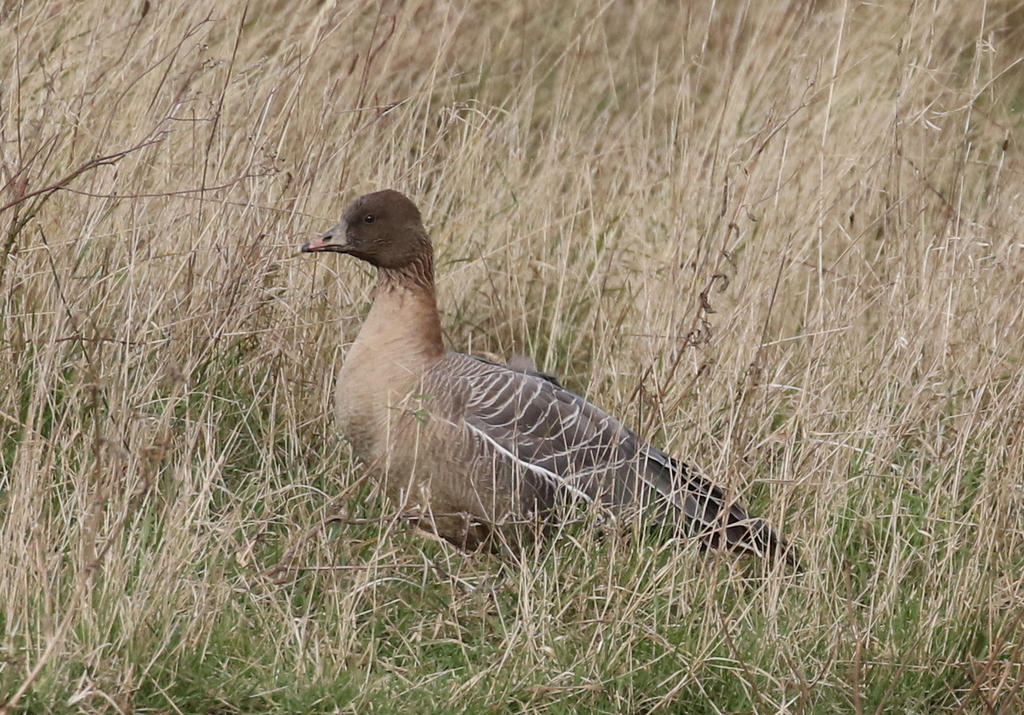
Making our way out to the edge of the Wash at Snettisham, a female Goldeneye was busy diving on the sailing club pit. When we got up onto the seawall, the tide was out, and we were presented with a vast expanse of mud. There were a few waders still closer in – Curlew, Redshank, Grey Plover and Knot, but most of the Dunlin were further out. We stopped to admire some of the closer birds in the scope, although it was not a place to linger today, given the wind. There was a liberal scattering of Shelduck over the mud too.
Our main target here was the owls, so we continued on round to see if we could find any. It didn’t take long to find one of the Short-eared Owls, tucked well in to a bramble bush, looking out. It was mostly dozing, its eyes closed. We got it in the scope, but it was very windy and hard to keep the scope steady. It was a little more sheltered a bit further down the path, so we stopped for a second look.

Continuing on round, we found a second Short-eared Owl roosting in the sparser brambles, back in its usual spot. A slightly paler individual, it stood out more against the vegetation. Again, it was mostly dozing but did wake up briefly at one point, flashing its yellow eyes.

It was good to be back on track with some owls now. After admiring the Short-eared Owls for a while, we decided to head back. A Cetti’s Warbler was singing half-heartedly in the dense brambles on the seawall, sensibly keeping tucked well in.
Making our way back along the seawall, we found a lot of the Dunlin were closer in now, a bit further north towards the start of the chalets. There has been a single Little Stint wintering here, one of probably only a handful wintering in the country, although with all the thousands of waders looking for it can be a bit reminiscent of needles in haystacks. We have mostly seen the Little Stint off Rotary Hide, but surprisingly we found it again, further up here today. It seemed to be mostly keeping to itself, running around on the mud, although it was getting blown around quite a bit in the wind.
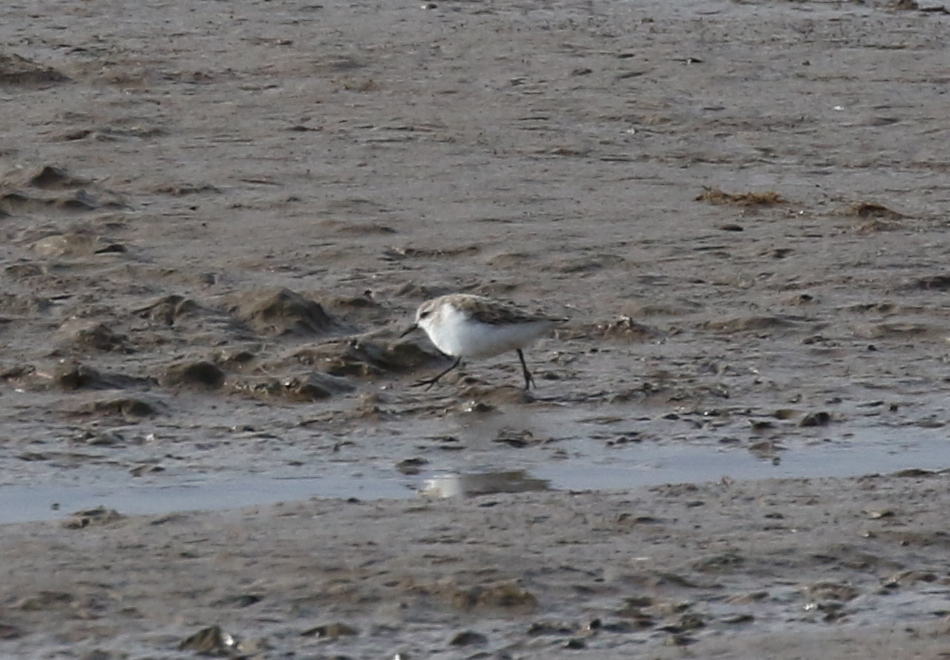
As we passed the sailing club pits, there were several Goldeneye now including a nice close male. We stopped to admire its glossy green head, bold white cheek patch, and bright golden yellow eye – whenever it resurfaced from its regular dives. More of a surprise, a darker duck on the pit further up was an immature drake Common Scoter. They are mostly sea ducks and not often seen on the pools here, and had presumably been blown in on the wind.

We made our way over to Titchwell next, for a break for lunch and a welcome hot drink. The ever helpful staff in the Visitor Centre told us that the Woodcock had been showing again this morning, so after lunch we made our way round to Meadow Trail. There were a few people already there who pointed out where it was. The Woodcock was very well hidden today, roosting down among the moss-covered branches, but from the right angle it was possible to get it in the scope for some frame-filling views.

Continuing on round to Patsys Reedbed, there were a few ducks out on the water here, mainly a small group of Gadwall and several Common Pochard, but we couldn’t see the drake Red-crested Pochard which was seen here earlier. We got the scope on a drake Gadwall so we could admire the intricacy of its feather patterning. Not just a dull grey bird – the connoisseur’s duck!
There were several Marsh Harriers up over the reedbed, with at least four together at one point, hanging in the wind. One landed on a small bush, where we could get a good look at it in the scope. More Marsh Harriers were further back, over Brancaster Marsh. A Kestrel landed on a tree just in front of the viewpoint too. A Common Buzzard was up along the ridge inland, where four Roe Deer were lying down in one of the fields.
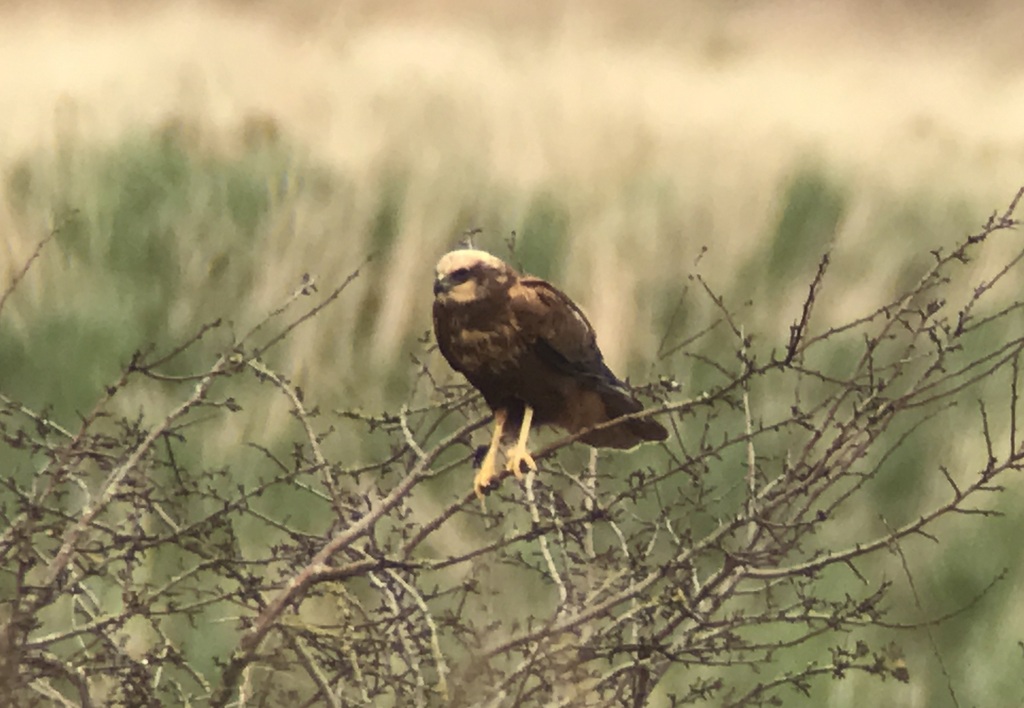
One of the volunteers told us that the Red-crested Pochard was tucked into the reeds, only visible from the far end of the pool. So we walked down and looked back to see it sleeping with some more Common Pochard. We could see its brighter orange head.
It was quite sheltered round at Patsy’s Reedbed and it seemed like the wind might have dropped. We cut back round onto the main path and when we got out of the shelter of the trees we found it was still very windy, though perhaps not quite as strong as this morning.
We made our way straight up to Island Hide, where we could get out of the wind. There were lots of Teal feeding right in front of the hide, the drakes looking very smart now in their breeding plumage. The numbers of Avocets have been steadily growing, as birds are already returning ahead of the breeding season. Two Black-tailed Godwits were asleep in with the feeding Avocets.
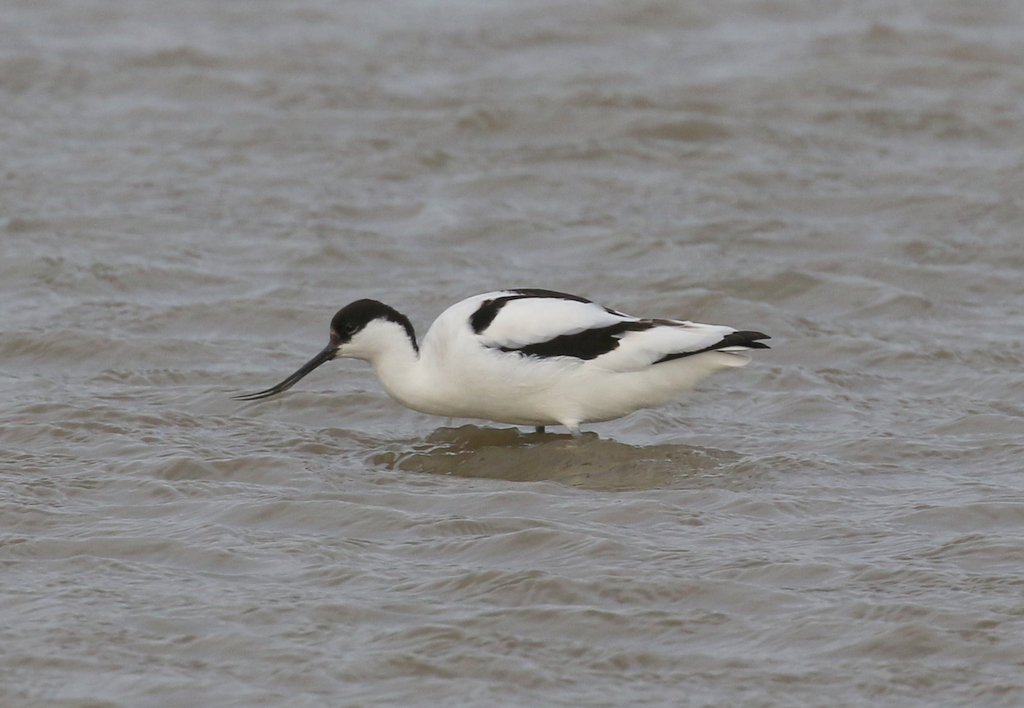
There were lots of gulls out on the Freshmarsh, and looking carefully through all the Black-headed Gulls, we found several Mediterranean Gulls in with them. Through the scope, we could see most were starting to get their dark, black hoods, contrasting with their white eyelids, and their bright red bills stood out too. There were several Common Gulls and Herring Gulls with them, and a single yellow-legged Lesser Black-backed Gull too. A Muntjac was working its way along the edge of the reeds.
We didn’t have time to explore the rest of the reserve today. As we walked back past the grazing meadow, there was no sign of the Barn Owl this afternoon, despite it being prime time now for it to be out. Perhaps it was just going to be too windy for them today.
Heading slowly back west, we kept scanning the likely fields, where we know Barn Owls like to hunt. Our luck was in, and as we passed a more sheltered meadow, we spotted a Barn Owl on a post at the back. It took off and flew towards us, but typically a car appeared behind us now and we were pulled up in the middle of the road on a corner.
There was somewhere to pull in further up and we walked back. The Barn Owl was on a post, under the trees, right by the gate now, so we edged our way down, trying not to disturb it. We needn’t have worried too much, as it eventually stayed where it was and didn’t mind us even when we got much closer, to find an angle from where we could get a clear look at it.

The Barn Owl was dozing. It looked round at us a couple of times, only half opening its eyes, but then tucked its head back in. It looked like it might be unwell, and it would be no surprise if it was struggling to find food at the moment, given the ongoing windy weather. Eventually it did take off again and flew further back to another post, looking round a little more actively. In windy weather, Barn Owls will often hunt from posts, scanning the ground below.
It was great to get our first Barn Owl of the day, and see it so close. Our luck was really in now, as we turned to see another owl hunting over the grass in the middle of the field. It was much browner than a Barn Owl, longer winged, and flying with stiff wing beats and a rowing-like action. It was a Short-eared Owl!
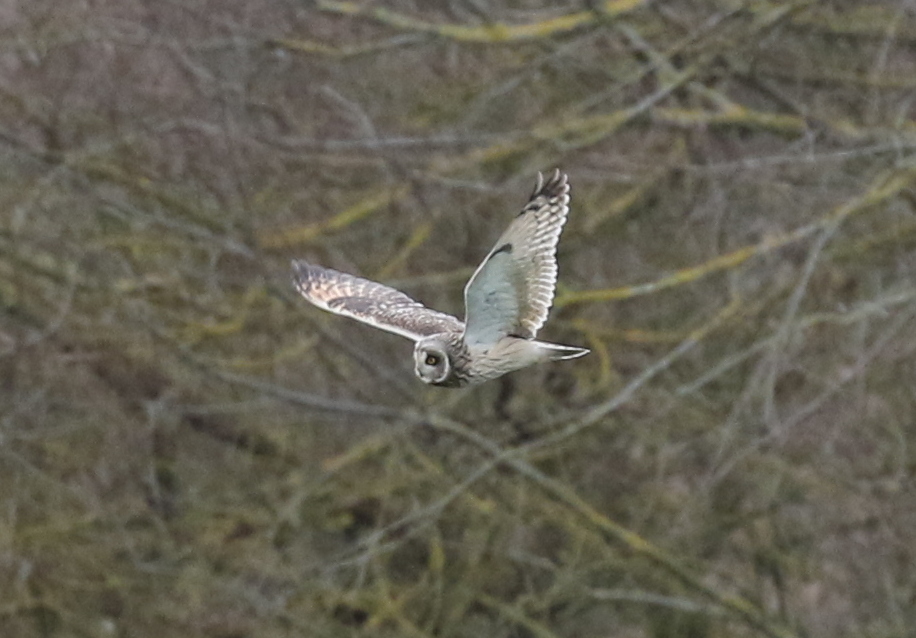
We watched as the Short-eared Owl worked its way round the far end of the meadow, before disappearing back through the trees. This is not a place we normally see them, so we wondered whether it might have come in from the grazing marshes to try to find somewhere more sheltered to hunt. A very nice bonus! While we were watching the Short-eared Owl, we noticed a second Barn Owl perched low down in the trees at the back of the meadow.
Continuing on to Holkham, we stopped again overlooking the grazing marshes. Five Spoonbills flew up as we arrived and disappeared round behind the trees, but as we stood and scanned, more Spoonbills flew in and out in ones and twos. This is another sheltered spot and we found our third Barn Owl of the afternoon, perched on a post on the edge of the marshes. Again it was not flying round hunting, but made its way between a couple of different perches, scanning the ground below.

Scanning the ditches and pools, we found a very distant Great White Egret out on the marshes. Then a second appeared from where it was hiding in a rush-lined ditch much closer and we had a good look at its long, snake-like neck and long, dagger-shaped yellow bill.
We could see a very distant group of White-fronted Geese and another small flock flew round calling, mixed in with some Greylags. Then we found some a little closer, out on the grazing marsh, so we could see their black belly bars and white surround to their bills. A flock of tits flew along the hedge behind us, and we picked out a single Goldcrest in with the Long-tailed Tits, Blue Tits and Great Tits as they worked their way past.
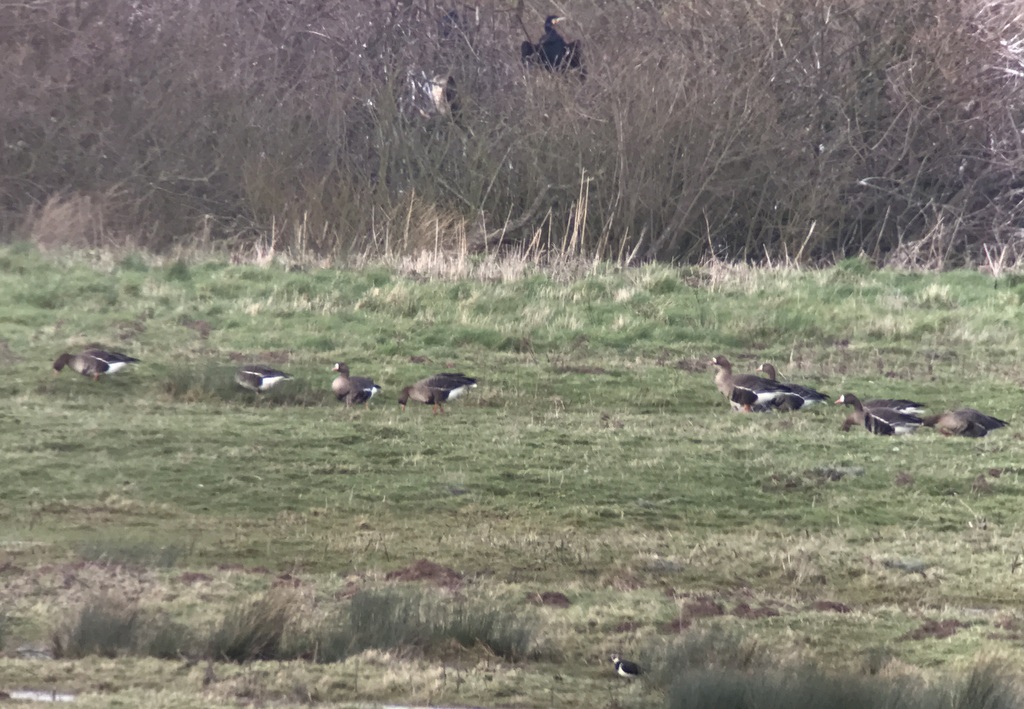
Time was getting on now and the light was starting to go. We hadn’t managed to see a Little Owl this morning, so we decided to have another throw of the dice and have a quick look at one site on our way back, in case one might be out hunting. It was still very windy though, and there was no sign. One to come back for another day! A Chinese Water Deer ran across the field as we drove round, adding to the day’s deer list.
We had done remarkably well for owls today, considering the weather, and everyone agreed we had enjoyed a great day out, with lots of other birds and wildlife too. We were so pleased we hadn’t had to cancel again. The moral of the story – it is always worth going out regardless!
















